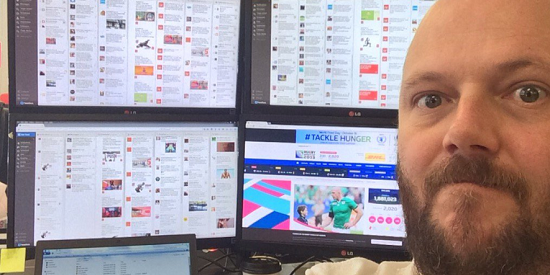 When you live your life as much on Facebook, Instagram, Snapchat and Twitter as you do in the real world, you need to live by a set of rules that helps you tell the difference. Especially if social media is also where you make your living. By Dave Luis
When you live your life as much on Facebook, Instagram, Snapchat and Twitter as you do in the real world, you need to live by a set of rules that helps you tell the difference. Especially if social media is also where you make your living. By Dave Luis
Picture it: Pretoria, 2004. A 56k modem shrieks its mating call and connects to the local exchange, and mIRC launches on my screen. mIRC – for millennials and other aliens – was a messaging internet relay chat and was one of the first social networks that Gen-X folk like me used to connect to people around the world. We were so edgy, back then.
A year later I created my first Flickr and myspace profiles. Blogging, Facebook and Twitter followed soon after. Along the way I documented the London bombings, Brighton Pride and the Nottinghill Carnival. You know. Big stuff. These were the days before Instgramming a buttered slice or badly painted finger nails became a ‘thing’.
Back in Johannesburg at my new job, the marketing team had an epiphany. “Hey! Let’s create a Facebook profile for our brand!” Crazy. Mad. Why would a brand want to play in this space? I scoffed at the idea. But it worked and people engaged. So we created another profile to teach South Africans the national anthem. And then we created three profiles as part of a campaign to recruit top talent into the business.
Suddenly, a whole new universe of ideas revealed themselves to us. Social media for a brand looked like it could just work.
The crystal ball that was my university aptitude test never predicted the rise of social media as a mainstream career. Who could have foreseen the advent of social media managers, digital agencies and content production houses? But nine years on, social media is a multibillion dollar industry and its how I earn my bread and butter. I get paid to chat all day on Facebook, Twitter and Instagram.
Of course it’s a lot more serious than that. I work with a team to analyse the trends of what people are saying about our brand online. We report operational issues at our various branches and resolve customer queries. We work tirelessly in shifts, seven days a week, to raise the awareness, reputation and engagement of our brand. We handle social media crisis communications when things go wrong and the Twitterati are baying for our blood.
Along the way, my personal social media profiles have grown. At last count, I have profiles on 27 different platforms, not counting the 6 dormant dating profiles that proclaim my love of long walks on the beach.
So what has working in social media for major brands taught me about how to manage my 33 personal profiles?
‘Think first, post later’ is a great maxim to live by. In the same way that you cannot unsay harsh and unkind words said in anger, posting an angry, sweary rant on Facebook has the potential to leave egg on your face…or worse. We’ve seen South Africans lose jobs and sponsorships when they have unwisely taken to social media when full beaches, freedom of expression or plush chairs at polo events have angered them. Brands and employers are beholden to public opinion more so than ever, thanks to social media, and if your rants offend, you are easily traced to your employer through your LinkedIn profile, or the work history you so proudly loaded on Facebook.
Privacy is never to be underestimated. The best privacy setting you have at your disposal is to not post that revealing photo or that drunken video where you proclaim undying infatuation for your boss, or your best friend’s wife. My rule of thumb here is if I wouldn’t say it to your face in a sober state, it’s probably not a great idea to post on Facebook or to share via Instagram.
Don’t tweet every single thought you have. Quite apart from being mind-numbingly dull and spammy, those endless streams of consciousness may be filled with unconscious bias. Loose tweets sink job opportunities.
Be kind. Or at least be civil. There are humans working behind the scenes on a brand’s social media account. So when you have a complaint and want it sorted out, even when you are at the end of your tether, keep it tidy. I’ve been embarrassed once or twice when I have ranted at my favourite grocery store or local mall only to later realise that the person handling the social media account is someone I know. Awkward doesn’t begin to describe it.
Fact check. When you’re sharing articles on social media, you’re potentially sharing information that could damage someone’s reputation. How sure are you that what is being said is true? Not everyone is as honest or as scrupulous as you, and many of them will write a status update painting themselves as innocent victim harshly treated by life, a brand or an ex. Be thoughtful of what you share.
The most important thing I have learned is that social media is not real life, and it’s easy to get caught up in the scandal of the day. Check out of social media often. Your virtual friends will be waiting for you when you log back in.
It’s quite simple. Treat people kindly, and don’t share the kind of stuff that could cause you embarrassment or cost you a job. Have fun. And don’t forget to share the kitten videos.

Leave a Reply